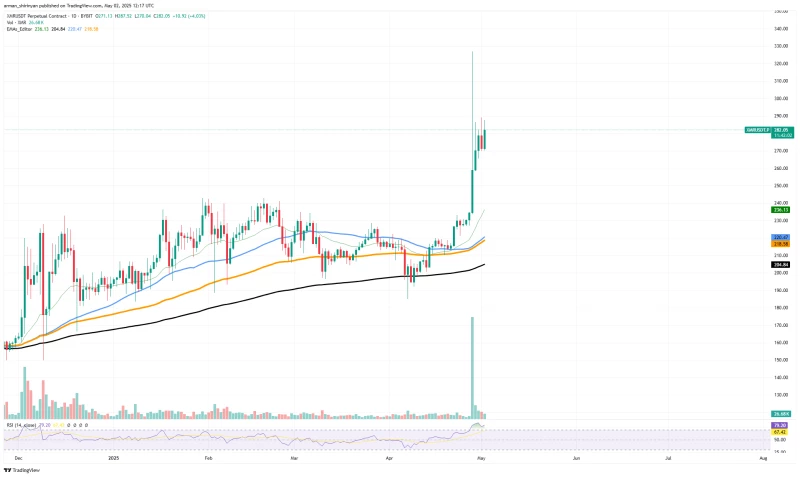Privacy-focused cryptocurrency Monero (XMR) shows remarkable resilience despite increasing regulatory pressure, climbing to $281 with unprecedented trading activity.
XMR Trading Volume Skyrockets 3,900% as Exchanges Begin Delisting
Monero (XMR), the leading privacy-focused cryptocurrency, is experiencing a significant market surge despite facing intensifying regulatory challenges worldwide. In the past 24 hours, XMR has climbed more than 3% to reach $281, a notable achievement in the current market conditions. However, the most striking development is the extraordinary 3,900% spike in trading volume, signaling an overwhelming wave of demand and market activity during this tumultuous period for the privacy coin.
This dramatic volume increase comes at a critical time for Monero as centralized exchanges have begun mass delisting the cryptocurrency, creating a unique market dynamic where regulatory pressure appears to be fueling rather than dampening investor interest.
Understanding Monero (XMR)'s Privacy Features That Concern Regulators
The regulatory scrutiny targeting XMR stems from its foundational privacy-by-default architecture, which sets it apart from mainstream cryptocurrencies like Bitcoin and Ethereum. While these larger cryptocurrencies offer only pseudo-anonymity with publicly viewable blockchain transactions, Monero employs sophisticated cryptographic mechanisms, including stealth addresses and ring signatures, that effectively conceal transaction participants and amounts.
These privacy-enhancing features have made XMR particularly attractive to users who prioritize financial privacy. However, these same features have put Monero on a direct collision course with international Anti-Money Laundering (AML) and Know Your Customer (KYC) regulatory frameworks that require financial transparency.

Numerous jurisdictions, especially in Europe and parts of Asia, have classified privacy coins like Monero as non-compliant with financial transparency regulations. This classification has created a challenging operating environment for XMR as centralized exchanges increasingly opt to delist the asset rather than risk regulatory penalties or accusations of facilitating illicit activities.
XMR Price Action Defies Technical Indicators Amid Exchange Exodus
In what market analysts describe as an ironic twist, the current regulatory purge appears to be driving Monero's price surge rather than suppressing it. The aggressive price movement and unprecedented volume explosion suggest traders and long-term holders are rushing to acquire or transfer XMR holdings before additional exchanges implement delisting measures.
From a technical perspective, Monero has shattered resistance levels, breaking out decisively from its consolidation around $220 and rapidly ascending to nearly $280. This impressive technical performance comes despite the Relative Strength Index (RSI) reaching 79, typically indicating overbought conditions that would normally suggest an imminent correction.
Market experts note that XMR's current rally appears to be reactive rather than organic, driven primarily by fears of future accessibility limitations rather than fundamental developments in the project itself. This fear-driven demand has created a rush toward decentralized solutions as users anticipate further restrictions on centralized platforms.
XMR's Future Depends on Adapting to Decentralized Ecosystem
Despite the current price momentum, Monero's long-term prospects on centralized exchanges remain precarious unless there's a significant shift in regulatory approaches toward privacy coins. The future viability of cryptocurrency will largely depend on how successfully it can transition to decentralized exchanges (DEXes) and cross-chain protocols that operate beyond the reach of traditional regulatory frameworks.
While the current rally may continue in the near term, driven by scarcity concerns and the rush to secure holdings, XMR's sustainable growth will ultimately hinge on its ability to adapt to life outside the established exchange ecosystem. The Monero community and development team now face the challenge of building infrastructure that can support the privacy coin in a potentially more decentralized future.
For privacy-focused investors, this regulatory pressure creates both opportunity and uncertainty. The current price action demonstrates strong market demand for XMR's unique privacy features, but questions remain about accessibility and liquidity if the regulatory crackdown continues to intensify.
As the situation develops, Monero stands as a fascinating case study in how regulatory pressure can sometimes create unexpected market dynamics, with the very efforts to restrict a cryptocurrency potentially driving increased demand in the short term.
Whether XMR can translate this reactive momentum into sustainable growth will depend on both evolving regulatory approaches and the privacy coin's ability to find alternative paths to market accessibility while maintaining its core privacy proposition that has attracted its dedicated user base.
 Saad Ullah
Saad Ullah

 Saad Ullah
Saad Ullah


